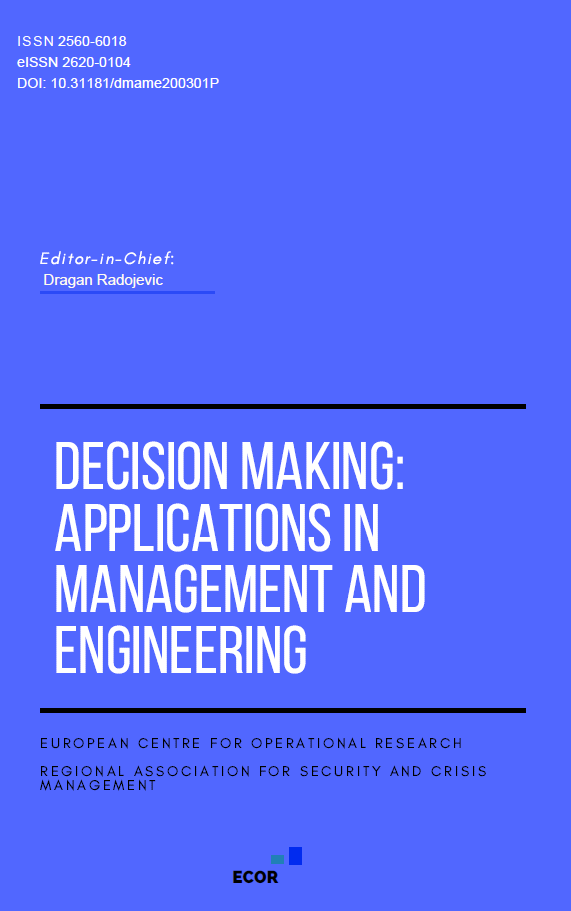Optimized RE-CNN-Based Multi-Objective Decision Framework for Visual Feature Evaluation in Computational Art Analysis and Interactive Media
DOI:
https://doi.org/10.31181/dmame7120241437Keywords:
Computational Art Analysis, Memorability, Sentiment Prediction, Aesthetic Evaluation, Zebra Optimization Algorithm, Random Ensemble CNN, Deep Learning.Abstract
Recent developments in digital art preservation have facilitated the integration of deep learning algorithms into decision-support systems by means of computational methodologies. This study proposes a hybrid approach employing the Zebra Optimisation Algorithm to enhance the performance of Random Ensemble-based Convolutional Neural Network (RE-CNN) models for the assessment of industrial product designs. By translating aesthetic evaluations, emotional responses, and memorability ratings provided by human reviewers into quantifiable insights, the model generates valuable operational guidance for visual media in the context of mechanical engineering design processes. Enhanced predictive capabilities are achieved through the optimisation of RE-CNN parameters, allowing for more accurate analysis of diverse product aesthetics. The advisory system presented offers design engineers and product developers a perceptual image generation tool tailored to achieving specific design goals. Product image evaluation is conducted by human assessors utilising systems that integrate decision-tree methodologies with content analysis protocols, enabling the interpretation of colour properties alongside visual elements. The system contributes to automated design decision-making by offering data-informed support for product selection within commercial environments. The adopted research methodologies contribute to the optimisation of mechanical systems and user interfaces, ensuring that visual and emotional design considerations remain paramount. Within artificial intelligence frameworks, engineers are thus able to create specialised products while accelerating the development of mechanical design systems
Downloads
References
[1] Abdelmalek, F., Afghoul, H., Krim, F., Zabia, D. E., Trabelsi, H., Bajaj, M., Zaitsev, I., & Blazek, V. (2024). Experimental validation of effective zebra optimization algorithm-based MPPT under partial shading conditions in photovoltaic systems. Scientific Reports, 14(1), 26047. https://doi.org/10.1038/s41598-024-77488-2
[2] Amin, R., El-Taweel, G., Ali, A. F., & Tahoun, M. (2024). Hybrid chaotic zebra optimization algorithm and long short-term memory for cyber threats detection. Ieee Access, 12, 93235-93260. https://ieeexplore.ieee.org/abstract/document/10521850
[3] Axelsson, Ö. (2007). Towards a psychology of photography: Dimensions underlying aesthetic appeal of photographs. Perceptual and motor skills, 105(2), 411-434. https://doi.org/10.2466/pms.105.2.411-434
[4] Bouckaert, G. (2025). Mind the Gap: A Strategy to Connect Humanities (Arts) with Social Sciences (Public Administration). The Humanities and Public Administration: An Introduction, Elgar Publishing. https://doi.org/10.4337/9781035333608.00022
[5] Chang, H. (2025). Decision Algorithm for Digital Media and Intangible-Heritage Digitalization Using Picture Fuzzy Combined Compromise for Ideal Solution in Uncertain Environments. Symmetry, 17(3), 443. https://doi.org/10.3390/sym17030443
[6] De Winter, S., Vissers, N., Bossens, C., & Wagemans, J. (2020). Instantaneous art? Investigating Frank Stella’s Moroccan Paintings with a short-exposure experiment. Art & Perception, 8(2), 121-157. https://doi.org/10.1163/22134913-bja10001
[7] Epstein, Z., Hertzmann, A., Creativity, I. o. H., Akten, M., Farid, H., Fjeld, J., Frank, M. R., Groh, M., Herman, L., & Leach, N. (2023). Art and the science of generative AI. Science, 380(6650), 1110-1111. https://doi.org/10.1126/science.adh4451
[8] Glebova, A. (2018). Elements of Photography: Avant-garde Aesthetics and the Reforging of Nature. Representations, 142(1), 56-90. https://doi.org/10.1525/rep.2018.142.1.56
[9] Guerra, A. (2025). Craft-Based Methodologies in Human–Computer Interaction: Exploring Interdisciplinary Design Approaches. Multimodal Technologies and Interaction, 9(2), 13. https://doi.org/10.3390/mti9020013
[10] Han, S., & Shi, Y. (2025). Music-oriented choreography considering hybrid density multimedia network algorithms. Journal of Computational Methods in Sciences and Engineering, 25(2), 1274-1288. https://doi.org/10.1177/14727978241298497
[11] Han, Y. (2025). Establish a novel neural network-based art design principles recognition model. Expert Systems with Applications, 279, 127073. https://doi.org/10.1016/j.eswa.2025.127073
[12] Heidegger, T., & Pandit, J. J. (2025). Difficult airway management: from the power of prediction to the art of management. In (Vol. 140, pp. 290-294): LWW. http://doi.org/10.1213/ANE.0000000000007202
[13] Marder, B., Erz, A., Angell, R., & Plangger, K. (2021). The role of photograph aesthetics on online review sites: Effects of management-versus traveler-generated photos on tourists’ decision making. Journal of Travel Research, 60(1), 31-46. https://doi.org/10.1177/0047287519895125
[14] Mohapatra, S., & Mohapatra, P. (2023). American zebra optimization algorithm for global optimization problems. Scientific Reports, 13(1), 5211. https://doi.org/10.1038/s41598-023-31876-2
[15] Muth, C., & Carbon, C.-C. (2024). Ambivalence of artistic photographs stimulates interest and the motivation to engage. Psychology of Aesthetics, Creativity, and the Arts, 18(3), 287. https://psycnet.apa.org/doi/10.1037/aca0000448
[16] Qi, Z., Peng, S., Wu, P., & Tseng, M.-L. (2024). Renewable Energy Distributed Energy System Optimal Configuration and Performance Analysis: Improved Zebra Optimization Algorithm. Sustainability, 16(12), 5016. https://doi.org/10.3390/su16125016
[17] Zhang, Y.-S. (2019). Model for art effect evaluation of fashion photography with triangular intuitionistic fuzzy information. Journal of Intelligent & Fuzzy Systems, 37(2), 1621-1627. https://doi.org/10.3233/JIFS-179226
[18] Rozental, S., van Dartel, M., & de Rooij, A. (2025). How Artists Use AI as a Responsive Material for Art Creation. International Symposium on Electronic/Emerging Art. https://research.tilburguniversity.edu/en/publications/how-artists-use-ai-as-a-responsive-material-for-art-creation
[19] Shi, Y., & Han, S. (2025). Multimedia interactive creative dance choreography integrating intelligent chaotic art algorithms. Journal of Computational Methods in Sciences and Engineering, 14727978251318055. https://doi.org/10.1177/14727978251318055
[20] Strand, M., Rivers, N., & Snow, B. (2022). Reimagining ocean stewardship: Arts-based methods to ‘hear’and ‘see’Indigenous and local knowledge in ocean management. Frontiers in Marine Science, 9, 886632. https://doi.org/10.3389/fmars.2022.886632
[21] Tang, X. (2022). Creation of Drama Art Based on Deep Learning and Evolution Strategy. Scientific Programming, 2022(1), 6217325. https://doi.org/10.1155/2022/6217325
[22] Trojovská, E., Dehghani, M., & Trojovský, P. (2022). Zebra optimization algorithm: A new bio-inspired optimization algorithm for solving optimization algorithm. Ieee Access, 10, 49445-49473. https://ieeexplore.ieee.org/abstract/document/9768820
[23] Wang, L.-J. (2022). Research on the application of hybrid density network combined with Gaussian model in computer music choreography. Journal of Sensors, 2022(1), 3385134. https://doi.org/10.1155/2022/3385134
[24] Wang, Q., & Yue, X. (2025). Dynamic Visual Effect Optimization of New Media Art Under the Integration of Visual Perception and Deep Learning. https://cad-journal.net/files/vol_22/CAD_22(S1)_2025_104-117.pdf
[25] Watts, R. (2016). Children's Perceptions of Beauty: Exploring Aesthetic Experience Through Photography University of Roehampton]. https://pure.roehampton.ac.uk/ws/portalfiles/portal/323622/R_Watts_PhD_Children_s_Perceptions_of_Beauty_8_6_16.pdf
[26] Wu, D., & Zhao, Q. (2024). Multimedia interactive creative dance choreography design integrating hybrid density network algorithms. International Journal of Information and Communication Technology, 24(8), 39-51. https://doi.org/10.1504/IJICT.2024.139863
Downloads
Published
How to Cite
Issue
Section
License
Copyright (c) 2025 Decision Making: Applications in Management and Engineering

This work is licensed under a Creative Commons Attribution 4.0 International License.












